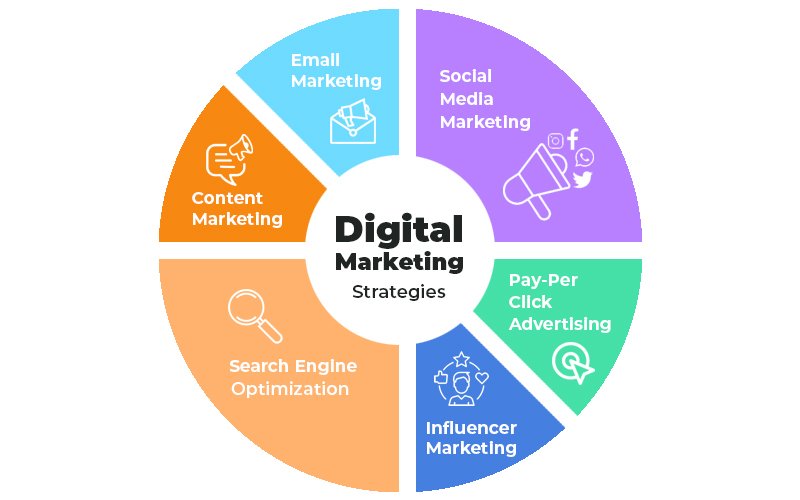
In today’s hyper-connected world, digital marketing isn’t a luxury—it’s a necessity. Whether you’re launching a startup, running a small business, or looking to modernize your marketing efforts, having a well-thought-out digital marketing strategy is crucial for online growth. But where do you start if you’re building one from scratch?
Let’s break it down step-by-step and build a strong digital marketing foundation tailored for your business
Step 1: Define Clear Goals and Objectives
Every great strategy begins with a goal. Ask yourself: What do you want to achieve with your digital marketing efforts?
Common digital marketing goals include:
- Increasing brand awareness
- Driving website traffic
- Generating leads or sales
- Boosting customer engagement
- Improving customer retention
Be specific and use SMART goals (Specific, Measurable, Achievable, Relevant, and Time-bound). For example: “Increase website traffic by 30% in the next 3 months.”
Step 2: Know Your Target Audience
Understanding your audience is critical to creating content and campaigns that actually convert.
Start by answering questions like:
- Who are your ideal customers?
- What are their demographics (age, gender, location, income)?
- What are their interests, needs, and pain points?
- Where do they spend time online?
Create detailed buyer personas to guide your messaging and ensure you’re speaking directly to your audience’s needs.
Step 3: Conduct a Competitor Analysis
Before building your own digital presence, look at what others in your industry are doing. Identify:
- Their strengths and weaknesses
- What platforms they’re using
- The type of content they post
- How they engage with their audience
- Their SEO strategy
Use tools like SEMrush, Ahrefs, or SpyFu to get a deeper look into your competitors’ online activities. This can help you uncover gaps or opportunities in your own strategy.
Step 4: Choose the Right Digital Channels
Not all digital platforms will be relevant to your business. Choose the ones that align with your audience and goals.
Here’s a breakdown of common channels:
- SEO (Search Engine Optimization): For long-term organic traffic growth
- Content Marketing: Blogs, eBooks, infographics to educate and engage
- Social Media Marketing: Build brand presence and connect with followers
- Email Marketing: Nurture leads and retain customers
- PPC (Pay-Per-Click): For immediate traffic via Google Ads, Facebook Ads
- Affiliate/Influencer Marketing: Leverage others’ audiences for growth
Your strategy doesn’t have to use all of these—start with a few and scale as you grow.
Step 5: Develop a Content Plan
Content is the backbone of digital marketing. It attracts visitors, builds trust, and drives conversions.
Here’s how to start:
- Brainstorm topics your audience cares about
- Decide on content formats (blogs, videos, podcasts, guides)
- Set a consistent publishing schedule
- Optimize content for SEO with the right keywords and metadata
Use a content calendar to stay organized and maintain consistency. Tools like Trello, Notion, or Google Sheets can help you keep everything on track.
Step 6: Build or Optimize Your Website
Your website is your digital home base. Make sure it’s:
- Mobile-friendly and fast
- Easy to navigate
- Optimized for conversions (CTAs, contact forms, live chat)
- SEO-optimized for search engines
If you’re starting from scratch, consider platforms like WordPress, Wix, or Shopify depending on your business type.
Step 7: Set Up Tracking and Analytics
You can’t improve what you don’t measure. Set up tools to track your performance from day one:
- Google Analytics 4: To track site traffic and user behavior
- Google Search Console: For SEO insights
- Meta Pixel (formerly Facebook Pixel): To track ad performance and conversions
- UTM Parameters: For tracking specific campaign performance
Review your data regularly to understand what’s working and what’s not, and adjust accordingly.
Step 8: Launch, Test, and Optimize
Digital marketing is not a one-and-done task—it’s an ongoing process of testing and refinement.
Start by launching your campaigns across your chosen channels. Monitor key performance indicators (KPIs) such as:
- Website visits
- Bounce rate
- Conversion rate
- Engagement metrics (likes, shares, comments)
- Cost per click (CPC) or acquisition (CPA)
Run A/B tests for headlines, images, CTAs, and email subject lines to optimize results. Even small tweaks can lead to major improvements.
Step 9: Build and Nurture Your Audience
Once you’ve started attracting traffic, it’s time to focus on engagement and retention.
- Encourage email sign-ups with lead magnets
- Use automated email sequences to nurture leads
- Reply to comments and messages on social media
- Create loyalty programs or exclusive content for returning users
Remember, it’s cheaper to retain a customer than to acquire a new one—so don’t forget about the post-sale journey.
Final Thoughts
Building a digital marketing strategy from scratch can seem overwhelming—but when broken down into steps, it becomes a manageable and rewarding process. The key is to start small, be consistent, and always keep learning. Digital marketing is constantly evolving, and the brands that adapt are the ones that thrive.
Start by setting clear goals, understand your audience deeply, pick the right platforms, and always measure your performance. With time, effort, and the right strategy, your online presence will grow—and so will your business.